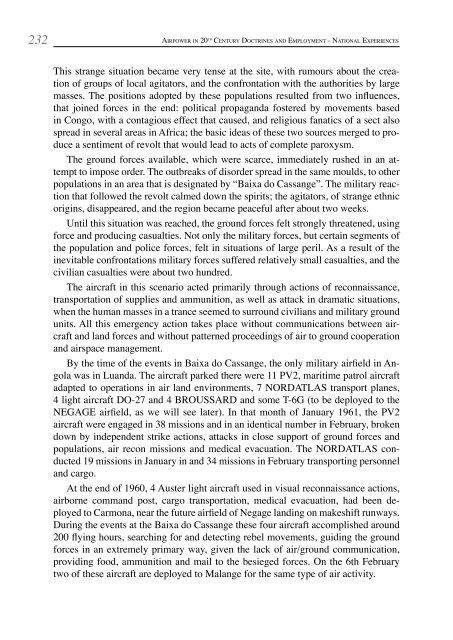National Experiences - British Commission for Military History
National Experiences - British Commission for Military History
National Experiences - British Commission for Military History
Create successful ePaper yourself
Turn your PDF publications into a flip-book with our unique Google optimized e-Paper software.
232 ai r p o w e r in 20 t H Ce n t u ry do C t r i n e s a n d em p l o y m e n t - nat i o n a l ex p e r i e n C e s<br />
This strange situation became very tense at the site, with rumours about the creation<br />
of groups of local agitators, and the confrontation with the authorities by large<br />
masses. The positions adopted by these populations resulted from two influences,<br />
that joined <strong>for</strong>ces in the end: political propaganda fostered by movements based<br />
in Congo, with a contagious effect that caused, and religious fanatics of a sect also<br />
spread in several areas in Africa; the basic ideas of these two sources merged to produce<br />
a sentiment of revolt that would lead to acts of complete paroxysm.<br />
The ground <strong>for</strong>ces available, which were scarce, immediately rushed in an attempt<br />
to impose order. The outbreaks of disorder spread in the same moulds, to other<br />
populations in an area that is designated by “Baixa do Cassange”. The military reaction<br />
that followed the revolt calmed down the spirits; the agitators, of strange ethnic<br />
origins, disappeared, and the region became peaceful after about two weeks.<br />
Until this situation was reached, the ground <strong>for</strong>ces felt strongly threatened, using<br />
<strong>for</strong>ce and producing casualties. Not only the military <strong>for</strong>ces, but certain segments of<br />
the population and police <strong>for</strong>ces, felt in situations of large peril. As a result of the<br />
inevitable confrontations military <strong>for</strong>ces suffered relatively small casualties, and the<br />
civilian casualties were about two hundred.<br />
The aircraft in this scenario acted primarily through actions of reconnaissance,<br />
transportation of supplies and ammunition, as well as attack in dramatic situations,<br />
when the human masses in a trance seemed to surround civilians and military ground<br />
units. All this emergency action takes place without communications between aircraft<br />
and land <strong>for</strong>ces and without patterned proceedings of air to ground cooperation<br />
and airspace management.<br />
By the time of the events in Baixa do Cassange, the only military airfield in Angola<br />
was in Luanda. The aircraft parked there were 11 PV2, maritime patrol aircraft<br />
adapted to operations in air land environments, 7 NORDATLAS transport planes,<br />
4 light aircraft DO-27 and 4 BROUSSARD and some T-6G (to be deployed to the<br />
NEGAGE airfield, as we will see later). In that month of January 1961, the PV2<br />
aircraft were engaged in 38 mis sions and in an identical number in February, broken<br />
down by independent strike actions, attacks in close support of ground <strong>for</strong>ces and<br />
populations, air recon missions and medical evacuation. The NORDATLAS conducted<br />
19 missions in January in and 34 missions in February transporting personnel<br />
and cargo.<br />
At the end of 1960, 4 Auster light aircraft used in visual reconnaissance actions,<br />
airborne command post, cargo transportation, medical evacuation, had been deployed<br />
to Carmona, near the future airfield of Negage landing on makeshift runways.<br />
During the events at the Baixa do Cassange these four aircraft accomplished around<br />
200 flying hours, searching <strong>for</strong> and detecting rebel movements, guiding the ground<br />
<strong>for</strong>ces in an extremely primary way, given the lack of air/ground communication,<br />
providing food, ammunition and mail to the besieged <strong>for</strong>ces. On the 6th February<br />
two of these aircraft are deployed to Malange <strong>for</strong> the same type of air activity.



